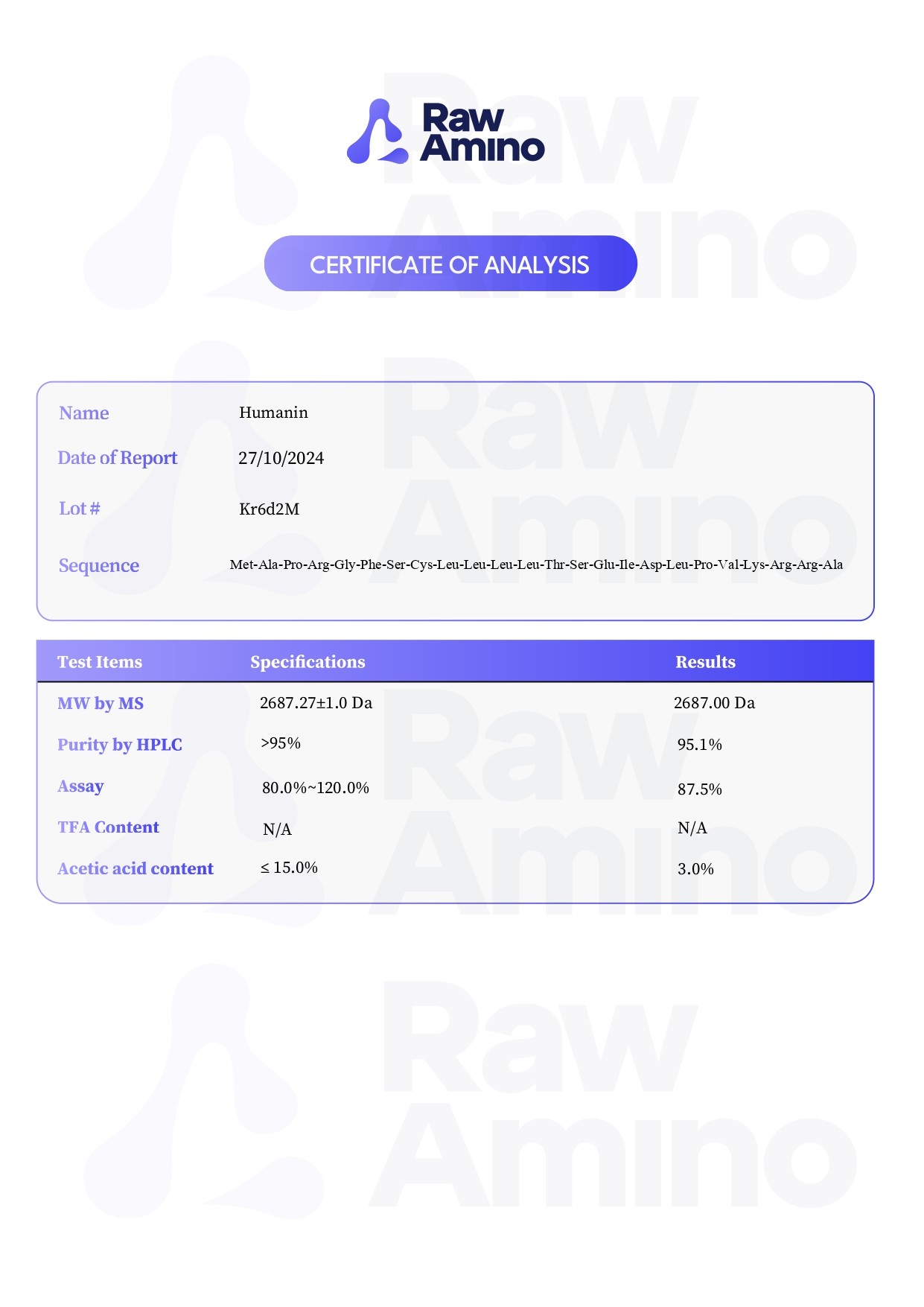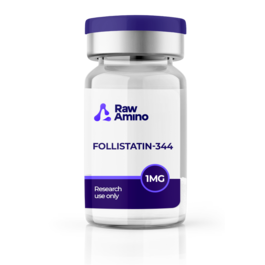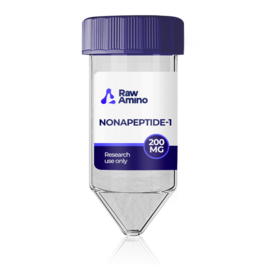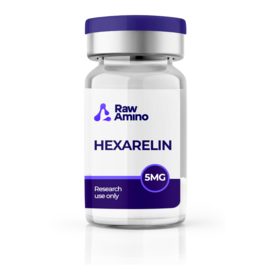
Humanin – 10MG
$143.00
Discount per Quantity
| Quantity | Discount | Price |
|---|---|---|
| 5 - 8 | 5% | $135.85 |
| 9 + | 10% | $128.70 |
Scientific Overview of Humanin
Humanin is a naturally occurring peptide encoded within mitochondrial DNA. Research indicates that this small peptide may appear in two main forms within cells: a 21-amino acid sequence inside the mitochondria and a slightly longer 24-amino acid version found in the cytosol. Both versions are thought to act as cytoprotective proteins and may support cellular resilience against programmed cell death (apoptosis). Studies suggest that Humanin appears to interact with proteins in the Bcl2 family, such as Bax, and may influence pathways related to apoptosis.
Alternative Names: formyl humanin, HNGF6A protein
Humanin Studies and Research Data
Investigations in Heart Cell Models
Research led by investigators at the Mayo Clinic has proposed that Humanin may be present along vascular walls, potentially reducing reactive oxygen species produced during LDL oxidation. Observations indicated a reduction in free radical presence and decreased markers of apoptosis in cardiac tissue models. Findings also suggest that Humanin might influence the Akt/GSK-3β signaling pathway, possibly encouraging cell survival processes in cardiomyocytes. Additionally, studies note a shift in cardiac tissue composition, with a higher proportion of cardiomyocytes relative to fibroblasts, along with lower fibrotic indicators such as collagen deposition and reduced expression of profibrotic cytokines like TGF-β1 and FGF-2.
Explorations in Neurodegeneration Models
In murine models of Alzheimer’s research, Humanin has been investigated for its potential influence on nerve cell resilience. Scientists note that the peptide may interact with G protein-coupled receptors such as FPRL-1 and FPRL-2, which are expressed on neurons. By binding to these receptors, Humanin appears to reduce the likelihood of amyloid beta binding, which may be linked to reduced plaque-associated damage. Other findings suggest that Humanin may also interact with proteins Bid and tBid, potentially contributing to the regulation of mitochondrial apoptotic pathways.
Humanin Laboratory Work on Retinal Cells
Retinal pigment epithelium (RPE) cells, essential for ocular function and vision maintenance, have been studied in relation to Humanin exposure. Findings suggest that Humanin may reduce oxidative stress within RPE tissues, supporting their structural and functional roles. Such cellular responses are considered significant in ongoing research related to macular degeneration and other ocular conditions, where oxidative stress is a contributing factor.
Research on Bone and Cellular Remodeling
Investigations from Sweden and South Korea suggest Humanin may play a role in supporting chondrocytes, cells involved in cartilage and bone matrix formation. In glucocorticoid-associated models of bone loss, Humanin exposure was associated with reduced cell death among chondrocytes. Other studies suggest that the peptide might interfere with osteoclast formation and activity, potentially through AMPK signaling pathways. By limiting osteoclast differentiation and function, Humanin may influence bone remodeling processes and mitigate markers of excessive bone breakdown.
Humanin Studies on Neurotoxicity Models
Research into Humanin’s role in neuronal stress models has examined its potential against toxins such as Calyculin A, which interferes with protein phosphatase activity and may trigger tau hyperphosphorylation. The peptide appeared to preserve neuronal viability in these experiments, with observations suggesting reductions in oxidative markers such as malondialdehyde and increases in antioxidant activity through enzymes like superoxide dismutase (SOD). These results also point toward restored phosphatase activity, which may help regulate tau phosphorylation and sustain neuronal integrity.
Insulin Signaling Investigations
Work in murine models has suggested that Humanin may play a role in supporting insulin sensitivity, particularly in liver cells. Evidence points to possible activation of STAT-3 signaling in the hypothalamus, which may influence peripheral glucose regulation. Additional studies note that Humanin exposure in diabetic models may lower blood glucose levels, though more research is needed to further clarify these associations.
Conclusion
Humanin has been widely studied across multiple experimental systems, from heart cells and neuronal models to retinal, bone, and metabolic research. Current findings suggest it may interact with apoptotic proteins, antioxidant pathways, and cellular signaling mechanisms, contributing to potential protective roles in various tissues. While the range of research is diverse, all outcomes remain preliminary, and further investigations are needed to better understand the peptide’s full scientific relevance.
References
- Qin Q, Mehta H, Yen K, Navarrete G, Brandhorst S, Wan J, Delrio S, Zhang X, Lerman LO, Cohen P, Lerman A. Chronic treatment with the mitochondrial peptide humanin prevents age-related myocardial fibrosis in mice. Am J Physiol Heart Circ Physiol. 2018 Nov 1;315(5):H1127-H1136.
- Kang N, Kim KW, Shin DM. Humanin suppresses receptor activator of nuclear factor-κB ligand-induced osteoclast differentiation via AMP-activated protein kinase activation. Korean J Physiol Pharmacol. 2019 Sep;23(5):411-417.
- Guo B, Zhai D, Cabezas E, Welsh K, Nouraini S, Satterthwait AC, Reed JC. Humanin peptide suppresses apoptosis by interfering with Bax activation. Nature. 2003 May 22;423(6938):456-61.
- Li Z, Sreekumar PG, Peddi S, Hinton DR, Kannan R, MacKay JA. The humanin peptide mediates ELP nanoassembly and protects human retinal pigment epithelial cells from oxidative stress. Nanomedicine. 2020 Feb;24:102111.
- Muzumdar, R. H., Huffman, D. M., Atzmon, G., Buettner, C., Cobb, L. J., Fishman, S., Budagov, T., Cui, L., Einstein, F. H., Poduval, A., Hwang, D., Barzilai, N., & Cohen, P. (2009). Humanin: a novel central regulator of peripheral insulin action. PloS one, 4(7), e6334.
- Niikura T. Humanin and Alzheimer’s disease: The beginning of a new field. Biochim Biophys Acta Gen Subj. 2022 Jan;1866(1):130024.
- Zhao, J., Zeng, Y., Wang, Y., Shi, J., Zhao, W., Wu, B., & Du, H. (2021). Humanin protects cortical neurons from calyculin A-induced neurotoxicities by increasing PP2A activity and SOD. International Journal of Neuroscience, 131(6), 527–535.
- Gong Z, Tas E, Muzumdar R. Humanin and age-related diseases: a new link? Front Endocrinol (Lausanne). 2014 Dec 4;5:210.
Disclaimer:
The products mentioned are intended solely for laboratory research and in-vitro experimentation. They are not approved for human or animal use of any kind. All details provided are for educational purposes only. By purchasing from this site, you agree to comply with our Terms and Conditions.
13 reviews for Humanin – 10MG
Only logged in customers may leave a review.







kristin_tran –
TracieX1 –
peptide677k –
AdamN12 –
Great experience ordering. Excellent quality and fast shipping. 📦
jose13 –
christina_jackson2 –
KimberlyA12 –
AlanL12 –
tammy3659 –
proto335k –
RachelOQ –
lab822x –
data50z –